Do you have a question about the Siemens RWF55.51A9 and is the answer not in the manual?
Specifies environmental requirements and site conditions for controller installation.
Explains the procedure for installing the controller into a panel cutout, including seal placement.
Covers safety regulations, external component connection, screw terminals, fusing, and correct usage.
Details the terminal assignments and provides connection diagrams for various controller outputs.
Explains high-fire operation with continuous burner run, including dynamic tests and response thresholds.
Covers methods for setting and shifting setpoints using buttons, analog signals, or binary inputs.
Covers configuration for weather-compensated setpoint adjustment using outside temperature.
Defines the response threshold for switching to high-fire operation based on actual value drop.
Describes the TSS function to prevent damage from rapid temperature changes.
Guides on manual control operations for modulating burners.
Explains manual control procedures for 2-stage burners.
Provides instructions for initiating the controller's self-setting (tuning) function.
Details parameters like Pb1, dt, rt, db, tt, HYS1-HYS6, and q.
Details configuration options for analog input 1, used for acquiring the actual value.
Configures analog input 2 for external setpoints or setpoint shifting.
Covers configuration for analog input 3, used for acquiring outside temperature.
Sets controller type, operating action, setpoint limits, and self-optimization.
Configures thermal shock protection and ramp functions for temperature control.
Details alarm functions for monitoring analog inputs and activating relay K6.
Configures binary outputs (K2, K3) and analog output (A+, A-) for control purposes.
Defines the usage of binary inputs for functions like setpoint changeover or operating mode changeover.
Sets up RS-485 or Profibus DP interfaces for data network integration.
Explains the self-setting function for tuning PID/PI controllers in modulating burner mode.
Provides methods to check and adjust controller parameters for optimal performance.
Highlights safety precautions for using ACS411 software with the controller.
Lists Modbus addresses and parameters accessible at the parameter level.
Specifies Modbus addresses and parameters for the configuration level.
Lists common alarm messages (e.g., 9999 flashing) and their causes and remedies.
Provides detailed technical specifications for controller inputs, including resistance thermometers and thermal elements.
Provides technical data for relays (K1, K2, K3, K6) and analog output.
Specifies environmental requirements and site conditions for controller installation.
Explains the procedure for installing the controller into a panel cutout, including seal placement.
Covers safety regulations, external component connection, screw terminals, fusing, and correct usage.
Details the terminal assignments and provides connection diagrams for various controller outputs.
Explains high-fire operation with continuous burner run, including dynamic tests and response thresholds.
Covers methods for setting and shifting setpoints using buttons, analog signals, or binary inputs.
Covers configuration for weather-compensated setpoint adjustment using outside temperature.
Defines the response threshold for switching to high-fire operation based on actual value drop.
Describes the TSS function to prevent damage from rapid temperature changes.
Guides on manual control operations for modulating burners.
Explains manual control procedures for 2-stage burners.
Provides instructions for initiating the controller's self-setting (tuning) function.
Details parameters like Pb1, dt, rt, db, tt, HYS1-HYS6, and q.
Details configuration options for analog input 1, used for acquiring the actual value.
Configures analog input 2 for external setpoints or setpoint shifting.
Covers configuration for analog input 3, used for acquiring outside temperature.
Sets controller type, operating action, setpoint limits, and self-optimization.
Configures thermal shock protection and ramp functions for temperature control.
Details alarm functions for monitoring analog inputs and activating relay K6.
Configures binary outputs (K2, K3) and analog output (A+, A-) for control purposes.
Defines the usage of binary inputs for functions like setpoint changeover or operating mode changeover.
Sets up RS-485 or Profibus DP interfaces for data network integration.
Explains the self-setting function for tuning PID/PI controllers in modulating burner mode.
Provides methods to check and adjust controller parameters for optimal performance.
Highlights safety precautions for using ACS411 software with the controller.
Lists Modbus addresses and parameters accessible at the parameter level.
Specifies Modbus addresses and parameters for the configuration level.
Lists common alarm messages (e.g., 9999 flashing) and their causes and remedies.
Provides detailed technical specifications for controller inputs, including resistance thermometers and thermal elements.
Provides technical data for relays (K1, K2, K3, K6) and analog output.
| Frequency | 50/60 Hz |
|---|---|
| Digital Inputs | 2 |
| Analog Inputs | 2 |
| Protection Class | II |
| Type | Controller |
| Temperature Range | 0 °C to +50 °C |
| Ambient Temperature Range | 0 °C to +50 °C |
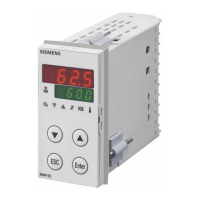


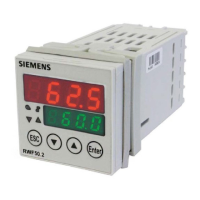
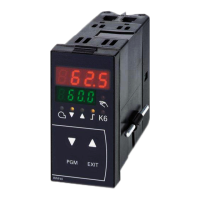
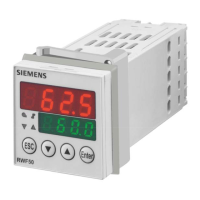
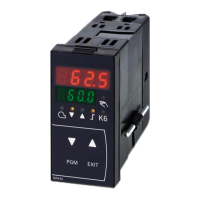
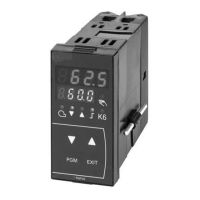



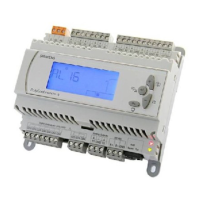
